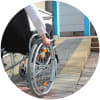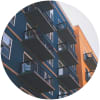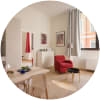How to Make Your Apartment Wheelchair Accessible

Apartment hunting is exciting, but can be challenging at times. The joy of a new home mixed with the frustration of not finding what you want can create a taxing atmosphere. Now, imagine if the process was made even harder by having extremely limited options.
For millions of renters in the U.S, this is a reality. Finding a home as a renter with a disability or as a renter who is wheelchair-bound can be challenging. Many apartments are not wheelchair accessible or designed with a handicapped renter in mind. Offering a handicap and wheelchair accessible apartment is a great way for landlords and property managers to reach these renters. Below we outline all the ways you can make your apartment more wheelchair and handicap accessible.
What is a Handicap Accessible Apartment?
A handicap accessible apartment is an apartment that has been modified to make the living space easy to access and live in by an individual who is wheelchair bound, uses a scooter or walker, or has limited mobility. Many people believe that a handicap accessible apartment relates to the Americans with Disabilities Act (ADA), but this is a misconception. The ADA applies to public buildings and common spaces, not individual units. To learn more, check out our guide on the ADA, HUD, accessible housing and renting with a disability. There are numerous ways to modify an apartment to make it handicap and wheelchair accessible.
How to Make Your Apartment Handicap and Wheelchair Accessible
There are numerous modifications you can make to your apartment to make it handicap and wheelchair accessible. Some of these modifications are simple and low cost, like installing support bars in the bathroom. Other modifications, such as widening doorways, can be more costly. Below are 28 ways to make your apartment handicap accessible.
General
- Install smooth flooring: Smooth flooring helps protect your floors from the wear and tear from a wheelchair, as well as eases the wheelchair’s movement.
- Widen entranceways and doorways to 32-35 inches wide: A standard wheelchair is 25 inches wide, so to ensure comfortable access doors should be 32-35 inches wide. Sometimes simply removing the door frame is enough. Other times the door will need to be remodeled.
- Lower electrical sockets and light switches: Make sure that electrical sockets and light switches are reachable from a wheelchair. This may mean moving the sockets down lower. This is particularly important in rooms like the kitchen, where sockets for appliances in a nonaccessible apartment may be located up high above the counter.
- Change light switches to rocker or touch-sensitive switches: Toggle light switches can be difficult for an individual in a wheelchair. Rocker switches or touch-sensitive switches can be easier to use from a seated position, and are easy to switch out in an apartment.
- Switch door knobs for lever handles: A lever handle is much easier to open from a wheelchair than a doorknob. This is a simple change that can make ease of access throughout the apartment much better.
- Install single-lever faucets: Lever faucets are easier to grip and maneuver than knob faucets, and an easy change to make your apartment more accessible.
- Install a personal alarm system: This device allows a renter with a disability to call for help if they are injured, sick, or need assistance but can’t reach a phone.
- Lower closet bars: In order for someone in a wheelchair to be able to fully access the closet throughout a household, lower the closet bars. This way the bars can be reached to hang clothing from a seated position.
- Rearrange the furniture: A simple way to make an apartment more accessible is to arrange the furniture so that a wheelchair can easily maneuver around. In the living room, for example, make sure that the couch is not blocked by a coffee table. If you offer furnished apartments, this can be an important yet easily overlooked way to make the apartment accessible.
- Offer a handicapped accessible parking space: If you have parking on the premise, make sure you have a designated handicapped parking space.
Entrance
- Install a wheelchair ramp on your doorstep: If you have stairs leading into your building or into your apartment, install a ramp so that a wheelchair can enter. Install railings too for safety.
- Smooth the entrance: Make sure that the entrance doorway does not have a bump or uneven surface so wheelchairs can easily enter.
- Install an automatic door opener: Installing a button to automatically open a door makes moving through entrance ways significantly easier for someone in a wheelchair.
- Lower the peephole: For the entrance to an apartment unit, lower the peephole for someone in a wheelchair. This way they can access the peephole while in a sitting position.
Kitchen
- Lower the countertops: Standard countertops are 36 inches high. However, a renter in a wheelchair can more easily access countertops that are 27 to 30 inches high. By lowering your countertops, you make the kitchen much more accessible.
- Make room down low: Make sure that there is room to move around the kitchen in a wheelchair. Having narrow spaces can make turning difficult. By removing some lower cabinets, wheelchairs can have more space to turn. If there is an island in the kitchen, make sure there is enough room for a wheelchair to maneuver around it.
- Ensure storage and cabinets are reachable: Wheelchair-bound renters are likely to have a hard time reaching items in high cabinets. Make sure there is storage down low where it is accessible. All of the essential kitchen items can be stored there.
- Place knobs on the front of the oven: If oven knobs are hard to reach, it can make cooking inaccessible for someone in a wheelchair. By installing an oven with knobs in the front for both the oven and stove, a renter in a wheelchair can easily reach them.
- Ensure appliances are accessible: Place appliances in spots where wheelchair-bound renters can access them. For example, make sure the dishwasher can be opened and loaded easily.
Bathroom
- Install support bars: Support bars, also known as grab bars, next to the toilet and shower are low-cost ways to make your apartment more accessible. These bars allow renters who are wheelchair-bound or have mobility issues to support themselves as they use these facilities.
- Install a handicap accessible shower or tub: If you want to go one step beyond installing support bars, you can install a handicap accessible shower or tub. These often have low entrances and raised seats for someone to sit on and to ease access.
- Install a shower bench: If you can’t install a fully handicap accessible shower or tub, you can make your current set up more accessible by adding a bench in the bathing area.
- Tilt the mirror: To make a mirror more accessible to someone in a wheelchair, install the bathroom mirror at a tilt. This way, even someone in a wheelchair can see themselves in the mirror.
- Raise the toilet seat: You can purchase toilet seat raisers to make it easier for someone in a wheelchair to use the toilet. A quick and easy fix.
- Wall mount the sink: Bathrooms can be tricky to navigate in a wheelchair. Creating space wherever possible helps. Wall mounting a sink adds extra space and creates a more accessible, open space in the bathroom.
- Lower the sink: If you can make changes to the sink, don’t just wall mount it, lower it. This way someone in a wheelchair can more easily reach the faucets.
How Much Does it Cost to Make an Apartment Wheelchair and Handicap Accessible?
If you are planning to entirely remodel your kitchen or bathroom, the cost for making your apartment handicap accessible is quite high. A full remodel can cost thousands of dollars. Expect to spend around $20,000 for a full remodel. However, as a property manager or landlord, such a remodel can be worthwhile if it will help you fill your apartments.
As the population ages, more renters will have accessibility needs. Having handicap accessible apartments could be very lucrative. Smaller changes, like installing support bars, will only cost a few hundred dollars to do, typically ranging from $100 to $300 to purchase and install the bars. Ramps range in price, from approximately $100 to upwards of $15,000. Widening doorways averages between $500-$1,000. While making an apartment handicap accessible will be an upfront cost, the rewards are huge as it makes your apartment appealing to a much broader range of renters.
How Do I Find a Wheelchair and Handicap Accessible Apartment?
Finding a wheelchair and handicap accessible apartment can be challenging. However, most new apartment buildings offer handicap accessible units. Multifamily properties, especially newer developments, almost always have apartments that will work for you. Use Apartmentlist.com to find your accessible apartment. Simply log in, go to your profile, and under amenities check “accessible”. We have accessible housing across the nation, so start your search there.
Share this Article



